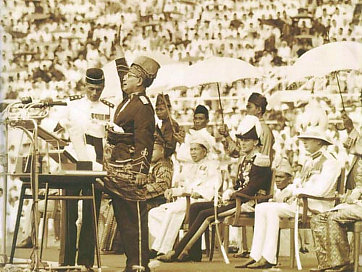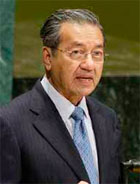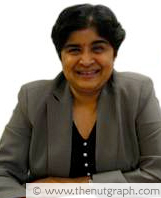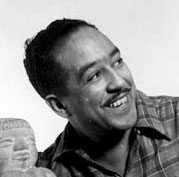
FORTY nine years ago, Malaysia’s first Prime Minister Tunku Abdul Rahman declared Malaysia’s birth, where “10 million people of many races…now join hands in freedom and unity”.
Yet, even as the Tunku proclaimed, “Merdeka! Malaysia!”, he acknowledged the contestations to Malaysia from Indonesia and Philippines that had to be overcome. Two years later, the vision of Malaysia was shaken again with Singapore’s separation in 1965.
What remains of the vision of Malaysia today? And how then do we celebrate Malaysia Day as Malaysians?
Cloudy vision
In many ways, what is Malaysia remains cloudy.
Although the Tunku declared in 1963 that the Federation of Malaya “now passes into history”, at times, it seems like Malaya still exists. Why else would our courts be hearing a Borneonisation suit by two Sabahans against the federal and state governments for failing to Borneonise federal agencies in Sabah, as agreed in the Malaysia Agreement 1963?

Meanwhile, Sabahans and Sarawakians were reportedly urged by former Prime Minister Tun Mahathir Mohamad to be patient and wait for natural resources to be extracted and foreign investments to materialise before experiencing comparable development with the peninsula. This is in spite of the fact that Sabah and Sarawak’s natural resources have been crucial to national growth over the last few decades.
Recent weeks have also seen a few instances of gross slander against the culture, religion, and lifestyle of Sarawakians.
Over on Peninsular Malaysia, there are the recurrent pendatang slurs, alleging that Indian and Chinese Malaysians are immigrants unworthy of citizenship. I, for one, still grapple with why the place my ancestors happened to live many years ago matters more to some than where I choose to call home today.
Citizenship and immigration
Then again, there are still complicated questions on citizenship today. Take the Royal Commission of Inquiry (RCI) on new citizens and illegal immigrants in Sabah. There has been well-founded ire against politicians and government officials who may have manipulated the boundaries of Malaysian citizenship for political advantage. But it is unfair to blame the new citizens and immigrants caught in these stratagems, most of whom simply want a decent chance of making a living.
Back again, to Malaysia’s 1963 formation. Like the Borneonisation of the civil service, immigration control was part of Sabah’s 20-point agreement for joining Malaysia. This control served an important purpose. In a UK Parliament debate over the 1963 Malaysia Bill, a member of Parliament said the North Borneo government used “very careful immigration policy”. They admitted only those who could genuinely contribute to local development, thus building “true racial harmony despite the advent of party politics”.

This stands in stark contrast to the issues driving the current RCI.
And then there is the case of Bersih co-chairperson Datuk Ambiga Sreenevasan, banned from entering Sarawak since last year’s state election campaign. Evidently, immigration is no longer a prerogative of the state for fostering strong communities. It has become a tool of the federal government for partisan designs.
Federalism
In fact, most political scientists wouldn’t consider Malaysia a true federation. A state cannot be federal unless it is meaningfully democratic.
 A proper federal system would give the final word to the central government in some matters and to the state governments in other matters. But when a country isn’t fully democratic, the ruling federal government can exert dominance beyond its official portfolio. Malaysia has numerous instances of this — consider, for one, the fact that PAS-led Kelantan does not receive oil royalties, while BN-led Terengganu, Sabah, and Sarawak do.
A proper federal system would give the final word to the central government in some matters and to the state governments in other matters. But when a country isn’t fully democratic, the ruling federal government can exert dominance beyond its official portfolio. Malaysia has numerous instances of this — consider, for one, the fact that PAS-led Kelantan does not receive oil royalties, while BN-led Terengganu, Sabah, and Sarawak do.
Another insight from political science is that every federation that is both stable and multinational also gives different legal and cultural rights to different states, to accommodate historic practices and present needs.
Although much of Malaysia’s diversity doesn’t fall along neat geographic lines, it is clear that the Borneo states have very different ethno-linguistic configurations from those of the peninsula. In theory, Sabah’s 20-point agreement and Sarawak’s 18-point version illustrate the sort of legal differentiation that has facilitated stability in other multinational federations. But in practice, a federal constitution that heavily centralises power combined with authoritarian rule has diminished these state-specific safeguards.
Learning to be Malaysians
How then can we learn to be Malaysians? A crucial step toward any common destiny is understanding who you share this destiny with. Many of us don’t know who our fellow Malaysians are.

At a Southeast Asian Studies conference I attended in Durham recently, anthropologist Monica Janowski presented her research on a gorgeous story from Kelabit lore. Janowski has been studying the Kelabit since before I was born.
When Janowski told the story of the Kelabit’s ancestors Tukad Rini and Aruring Manapo Boong, I felt as I did while watching native dance performances at the Sarawak Cultural Village: I was jealous. Why hadn’t I seen any of this before? I had spent years in sekolah kebangsaan, but reading about tarian ngajat in a Form 2 history textbook was nothing compared to watching a ngajat lesung dancer glide across the stage with a 20kg mortar between his teeth.
This presents the government with both an obligation and an opportunity. The new education blueprint discusses in detail both the expansion of information technology in classrooms and cultivation of national unity in schools. Why not use the former to aid the latter? Travelling across the South China Sea is beyond the means of many Malaysians, but YouTube is within easy reach. If the abundance of Malaysia’s heritage can be filmed for slick Malaysia, Truly Asia videos such as the one below to attract non-Malaysians to our economy, surely it can also be showcased digitally to help Malaysian students to value their own.
Bangsa Malaysia videos would only be a tiny step — and may well become another poorly implemented gimmick — but we need many such steps if we want to get anywhere together.
We cannot depend solely on the heroic work of organisations like Gerai OA, the Center for Orang Asli Concerns, and Saya Anak Bangsa Malaysia. Any government that wants to legitimately call itself the government of Malaysia needs to join in helping Malaysians appreciate each other.
Malaysiaku bahagia
This is what I celebrate on Malaysia Day: not a seamless federation, but all that we are and all that we can become, individually and collectively, remembered and forgotten. Because sometimes we need to pause and reaffirm the dreams that make us one people.

These dreams may be sentimental, but they’re also audacious and demanding — and worthwhile. I don’t know a better way to love my country, broken federalism, beautiful unfamiliar ethnicities and all.
To paraphrase American poet Langston Hughes: let Malaysia be Malaysia again — the land that never has been yet — and yet must be — the land where everyone is free. ![]()
Hwa Yue-Yi is a Malaysian student.


stewoolf says
Approaching mid life then I realised dogs are considered “haram” in Islam! Growing up reading four newspapers, two Chinese and two English/Malay, faithfully and daily, and every issue of Newsweek, Times and Readers’ Digest, and being the top student in school, yet I failed to learn much about Islam as a non-Muslim in our fragmented and broken education system. Ironically, out of school in Form Two, I learned the concept of time in relativity, the three basic categories of materials in the periodic table according to electricity conductivity and read “Dream of the Red Chamber” in Chinese classical text. All thanks to the wonderful town library which is going to be torn down soon.
KTWong87 says
Hwa Yue-Yi has made a commendable effort, but alas, appears to have become confused between the formation of Malaysia 49 year ago in 1963, and the formation of Malaya 55 years ago in 1957.
When the Tunku proclaimed “Merdeka! Malaysia!” (as illustrated by the photo, it was in 1957, and there was no issue with “contestations to Malaysia from Indonesia and Philippines”.
If I am correct, then may I strongly suggest that the editor(s) of The Nut Graph be more diligent with the fact-checking of works by students like Hwa Yue-Yi?
Jo-Ann says
Thank you for your comment. The fault, if any, does not lie with the author. Tunku Abdul Rahman did in fact proclaim, “Merdeka! Malaysia!” on 16 Sept 1963 as can be seen in his Malaysia Day speech – click the first hyperlink. The illustration, admittedly, does not refer to the Tunku on Malaysia Day but it was difficult to source for publicly available photographs of him on that day. We apologise for the confusion.
Alwin Lim says
All the problems that we see, and there are tonnes of them, have weakened the nation. If we can achieve bangsa Malaysia or at least put it as the goal, much of the problems will be solved. Being a citizen of Malaysia means that [there are] privileges granted but also responsibilities as citizens. A true citizen who loves the country will fight against corruption with all his might because it is detrimental to the country.
If we all put country first then most problems will go away because citizens will start protecting and looking out for each other regardless of race. Now that we have new immigrants whether legal or illegal coming in en masse, can they too be integrated in our society? Can we now accept Myanmarese, Bangladeshi, African, Indonesian and Vietnamese as part of Malaysia? Don’t forget the fact that We are actually living next to each other now. Would it pose greater problems in the future when they too make demands about how the country should be run? While we are still harping on the citizenship of the non-Malays, there are scores of new immigrants granted citizenship not by virtue of strict immigration rules but by corruption and mismanagement. Do we still harp on the citizenship issue of the non-Malays when in the future the immigrants want to be citizens of the country legally or illegally while we degrade the natives by calling them “dan lain-lain”? How can we have the best of the Malays, the Chinese, the Indians and others as how our prime minister puts it in advertisements when we do not include them as one and openly call them as “others”. At the very least, Myanmarese, Bangladeshis,and Indonesian workers are not known as “others” while the natives are being openly placed in this category.
How can we categorize our national diver who brought us fame by winning an Olympic bronze medal as “the others” when she won it with all her heart as a Malaysian? Take Hannah Yeoh for example she wanted to register her child as Malaysian Race but was rejected because “the system” cannot be changed [to accomodate] the national identity. The national identity cannot implemented or is the system created [as such] so as to not allow it to be implemented? Is ticking a form for a bank loan to categorize a person on the race column considered racist? Why waste time creating that column that segregate bank customers? If we integrate the new immigrants, would this mean we have to create another column for bangsa Afrika, Myanmar, Indonesia in our forms and still put the natives in the very last column as dan lain-lain? Shouldn’t we have laws to punish those who proudly proclaim that if a particular race are not happy about corruption and mismanagement to go back to their country or we take back their citizenship? Which country is he going to go to when he is busy trying to protect his country from blatant corruption and mismanagement? Shouldn’t he be awarded “citizen of the year” instead? After 55 years, [isn’t it about time] for the people of this country to understand the distinction between a citizen who loves the country instead of a person who corrupts the country and puts the blame on race and its citizens to cover all his wrongdoings? Can and will Malaysians allow this to happen? There is still hope and unless Malaysians are ready to walk that hope, no other people in any country w[ill] walk that for you, either you claim back your country or other new citizens and the corrupters will claim your land we so dearly call home.
stewoolf says
What is truly Malaysia? She doesn’t seem to know what she wants to be when celebrating her 49th birthday. An Islamic state? Or a Malay-land based on “Ketuanan Melayu”? What about a secular, colour- blind meritocracy? Being patriotic is a meaningless, even dangerous, pursuit. Both sides of the American Civil War were patriotic enough to risk their lives defending their conflicting American ideals. 600,000 soldiers perished. How can we achieve our Malaysian ideal without paying such a high price? Simple, by engagement.
Under BN’s divide and rule, inter-ethnic engagement is public enemy number one. Religious pluralism is a no-no for the Muslim establishment, so no multi-religious council. Butt dancing, forum crashing, and burning of anti-idols seem to be a good way to argue for “Ketuanan Melayu”. China town Malaysia is not a tourist attraction. It’s way of life. The media is not to inform, nor to educate, much less to engage, just for propaganda.
stewoolf says
The governments elected in GE13 and GE14 and what they do would set the tone for Malaysia to settle down as a mature nation. The single and overwhelming factor that determines what Malaysia becomes is money! Yes, economic progress.
A survey on Muslim immigrants to North America and Western Europe found that the percentage of first and second generation immigrants became secular and non-religious (non-practising or atheist) is similar to that of the local Christians.
I surmise that would happen in Malaysia if more Muslim Bumis enter the middle class. That would end the Islamic state.
“Ketuanan Melayu” would be viable if the Malay:Chinese population ratio is 30:70. If it is reverse, only 5% of Malays would benefit. Guess which 5%, so far??
Bottom line: how to and WHO can upgrade our economy, AND ensure the Malay masses earn their share?